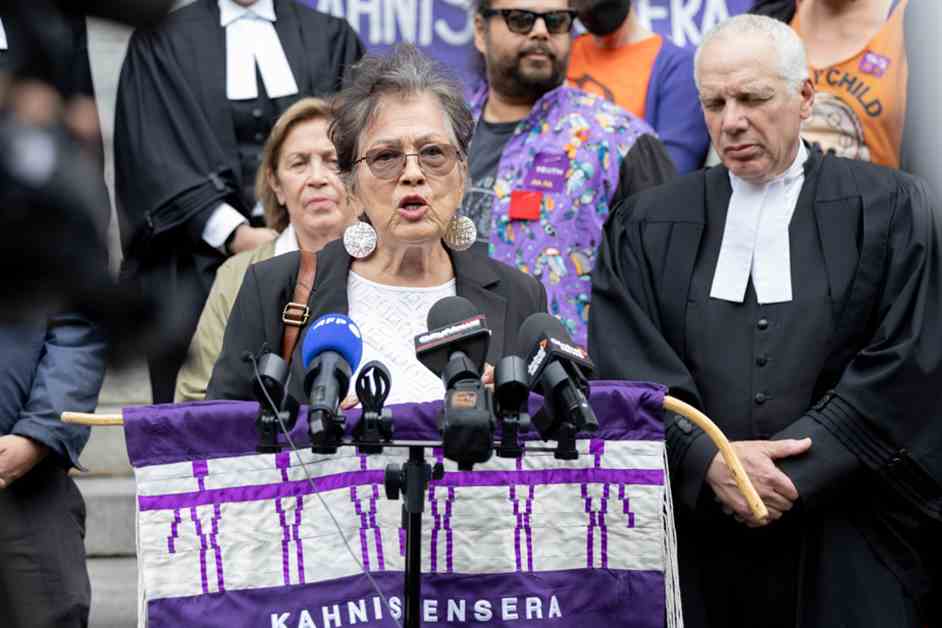The Kanien’kehà:ka Kahnistensera, also known as the Mohawk Mothers, suspect that unidentified Indigenous and non-Indigenous burials may have been illegally buried at the former Royal Victoria Hospital in the 1950s and 1960s.
The Mohawk Mothers claim that McGill University and the Société québécoise des infrastructures (SQI) are trying to bury them under legal procedures, while new evidence of human remains possibly being on the site of the former Royal Victoria Hospital has recently been discovered.
On Tuesday, in a new step in this long legal saga, the Quebec Court of Appeal heard McGill and the SQI regarding a judgment of the Quebec Superior Court rendered on November 20, 2023. Justice Gregory Moore had granted McGill and the SQI the right to continue excavation work, under certain conditions.
McGill and the SQI have been working for a few years on a project to expand the campus of the Montreal university on this site at the heart of the legal battle. However, the Mohawk Mothers suspect that unidentified Indigenous and non-Indigenous burials may have been illegally buried there in the 1950s and 1960s.
« We are not only talking about technical details, but we are talking about living people who have passed away, » said Kwetiio, a member of the Mohawk Mothers.
The SQI and McGill oppose Justice Moore’s decision to reinstate a panel of experts who were tasked with developing an archaeological research plan before McGill terminated their contract in July 2023.
The SQI also accuses the Mohawk Mothers of trying to renegotiate the agreement that all parties had signed on the archaeological research processes of the site.
« In fact, what the [Mohawk Mothers] are trying to do is to modify the agreement, » said the SQI’s lawyer, Vicky Berthiaume, before the Court of Appeal. « The highest standards of archaeology have been followed. »
The Kanien’kehà:ka Kahnistensera do not share the same opinion. They are supported by lawyer Julian Faulkner, representing the independent special interlocutor for missing children and anonymous graves and burials related to Indian residential schools, appointed by Ottawa.
« We continue to receive reports. Historical human remains detection dogs tell us that remains are being identified, » said Faulkner. « And McGill does not want to open the buildings to find out where the smells [detected by the dogs] are coming from. McGill continues to advance the project hoping that the Mothers will disappear. »
In recent years, across the country, discoveries of Indigenous burials have brought to light the buried and forgotten secrets of the treatment of Indigenous peoples and vulnerable individuals in Canada.
From the 1950s to the 1960s, the Central Intelligence Agency (CIA) funded psychiatric experiments on patients at the Allan Memorial Institute, located on the site of the Royal Victoria Hospital, through various controversial and harmful techniques that left lasting effects on the victims of these treatments.
The Mohawk Mothers, in collaboration with the Duplessis Orphans, are also fighting a similar case, this time against the Société des alcools du Québec (SAQ). The SAQ is trying to expand its warehouse on the site of the former Saint-Jean-de-Dieu psychiatric hospital, despite concerns from these two groups, who claim that victims may have also been buried under this site in eastern Montreal. Representatives of the Duplessis Orphans were also present at the Quebec Court of Appeal today to support the cause of the Mohawk Mothers.
They are not the only ones dealing with such an issue. In recent years, discoveries of Indigenous burials across the country have shed light on the buried and forgotten secrets of the treatment of Indigenous peoples and vulnerable individuals in Canada.
Appointed by the Minister of Justice and Attorney General of Canada, independent special interlocutor Kimberly Murray’s mission is to work with experts, survivors, and Indigenous communities on the best way to address the sensitive issue of anonymous burials and graves.

